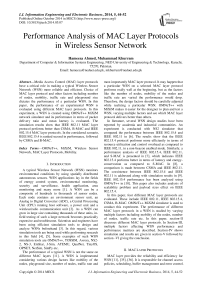Performance Analysis of MAC Layer Protocols in Wireless Sensor Network
Автор: Hameeza Ahmed, Muhammad Khurram
Журнал: International Journal of Information Engineering and Electronic Business(IJIEEB) @ijieeb
Статья в выпуске: 5 vol.6, 2014 года.
Бесплатный доступ
Media Access Control (MAC) layer protocols have a critical role in making a typical Wireless Sensor Network (WSN) more reliable and efficient. Choice of MAC layer protocol and other factors including number of nodes, mobility, traffic rate and playground size dictates the performance of a particular WSN. In this paper, the performance of an experimental WSN is evaluated using different MAC layer protocols. In this experiment, a WSN is created using OMNeT++ MiXiM network simulator and its performance in terms of packet delivery ratio and mean latency is evaluated. The simulation results show that IEEE 802.11 MAC layer protocol performs better than CSMA, B-MAC and IEEE 802.15.4 MAC layer protocols. In the considered scenario, IEEE 802.15.4 is ranked second in performance, followed by CSMA and B-MAC.
OMNeT++, MiXiM, Wireless Sensor Network, MAC Layer Protocols, Mobility
Короткий адрес: https://sciup.org/15013303
IDR: 15013303
Текст научной статьи Performance Analysis of MAC Layer Protocols in Wireless Sensor Network
Published Online October 2014 in MECS
A typical Wireless Sensor Network (WSN) monitors environmental conditions by using spatially distributed autonomous sensors. WSN applications lay in the fields of energy control system, environmental monitoring, security and surveillance, health application, area monitoring and many more [1]. A WSN can be a composite of hundreds to thousands of sensor nodes. Each node contains an environment sensor unit, an Analog to Digital Converter (ADC), a Central Processing Unit (CPU) running host software, a power unit and a wireless/radio communication unit [2]. As a WSN can grow in large size containing thousands of these units, infield testing of such a large network becomes practically expensive and troublesome. Scientists and engineers have been using efficient simulation tools to design and analyze WSNs beforehand [3]. In this regard, various simulation tools are being used while performing research in this field [4], [5]. Some examples of such WSN simulation tools are OMNeT++, TOSSIM, Avrora, NS2-2, NS-3, EmStar, J-Sim, ATEMU, QualNet, TinyOS, OPNET, NetSim, SimPy etc.
The performance of a typical WSN is not the same on different MAC layers [11]. A WSN is implemented considering various design factors like mobility of the nodes, playground size, number of nodes, traffic rate and most importantly MAC layer protocol. It may happen that a particular WSN on a selected MAC layer protocol performs really well at the beginning, but as the factors like the number of nodes, mobility of the nodes and traffic rate are varied the performance would drop. Therefore, the design factors should be carefully adjusted while realizing a particular WSN. OMNeT++ with MiXiM makes it easier for the designer to plan and test a WSN, varying multiple factors and see which MAC layer protocol delivers better than others.
In literature, several WSN design studies have been reported by academia and industrial communities. An experiment is conducted with NS2 simulator that compared the performance between IEEE 802.15.4 and IEEE 802.11 in [6]. The results show that the IEEE 802.15.4 protocol performs more efficiently in terms of resource utilization and control overhead as compared to IEEE 802.11, in a non-beacon enabled mode. Similarly, a performance analysis of IEEE 802.15.4, IEEE 802.11, and S-MAC is presented in [7], which indicates IEEE 802.15.4 performs better in terms of latency and energyconservation as compared to S-MAC. In [8], a comparison is made between CSMA and IEEE 802.11. The coexistence between IEEE 802.15.4 and IEEE 802.11 is addressed along with simulation results in [9]. IEEE 802.15.4 performance has been analyzed using OMNeT++ in [10]. This paper also includes analysis of scalability problem and payload sizes effect on IEEE 802.15.4.
In this paper, four different MAC layer protocols are evaluated. These include IEEE 802.11, IEEE 802.15.4, CSMA, B-MAC. OMNeT++ MiXiM simulator is used to conduct this experiment. The performance of different MAC layer protocols in a WSN is studied by varying multiple factors including mobility of the nodes, number of nodes, traffic rate etc. In this paper, section-II discusses different MAC layer protocols. In Section-III, multiple factors affecting WSN performance and performance matrices are described. Section-IV shows simulation and results are given in section-V followed by section -VI giving the conclusion.
-
II. MAC Layer Protocols
MAC layer provides the reliability and efficiency for WSN [11], [35], [36]. It is responsible for channel access policies, scheduling, buffer management and error control.
As per OSI model, shown in Fig. 1, MAC layer is a sublayer of the data link layer (DLL) [12]. It handles channel access, frame-level error prevention, detection and correction. A MAC protocol provides framing, medium access, reliability, flow control, and error control [13]. MAC protocol regulates access to the shared medium by which application performance requirements are satisfied [14].

Fig. 1. Network OSI model with 7 layers in descending order
In WSN systems, different MAC layer protocols are used [13]. Some of the popular MAC layer protocols are briefly discussed as follows.
-
A. CSMA and CSMA/CA
Carrier Sensed Multiple Access (CSMA) is a random access protocol to control access to the network. Devices attached to the network first sense the channel and then transmit if and only if they get an empty channel otherwise if the channel is busy devices attempt to wait. It is widely adopted in wireless networks due to its simplicity and distributed nature [15]. In Carrier Sense Multiple Access/Collision Avoidance (CSMA/CA) technique a node signals its intent to transmit earlier which results in collision avoidance. Due to excessive overhead this technique is not so famous [16].
-
B. IEEE 802.11
This technique is contention based medium access control protocol for implementing wireless local area network (WLAN). It avoids collisions in data packets through carrier sensing and randomized back-offs techniques. Its main characteristics include simplicity, flexibility and cost effectiveness [17], [18].
C. IEEE 802.15.4
This technique is uniquely designed for low rate wireless personal area networks. It focuses on low data rate, low power consumption and low cost wireless networking and offers device level wireless connectivity.
It can benefit different applications such as those using sensors that control lights or alarms, wireless computer peripherals, wall switches that can be moved at will, inventory tracking devices etc [6].
-
D. B-MAC
Berkeley MAC (B-MAC) protocol is widely used in WSNs. This protocol uses adaptive preamble sampling scheme in which medium is sampled at fixed time intervals. BMAC focuses on effective collision avoidance, efficient channel utilization and low power operation [19], [20].
-
E. Aloha
In Aloha, a transmitter can send packet at any time without coordinating between nodes. Pure aloha, slotted aloha and aloha with preamble sampling are used as aloha protocols [21].
-
F. LMac
Lightweight Medium Access (LMAC) protocol allows each node to select a timeslot from its one-hop neighbors using slot occupancy information [22].
-
III. Performance Affecting Factors and Performance Matrices
-
A. Multiple Factors
Some of the factors that influence performance of a MAC layer protocol in a Wireless Sensor Network (WSN) are mentioned below.
Mobility : With the recent developments WSNs are not just stationary but they provide mobility as well [23]. They are referred as "mobile sensor networks" such as moving robots, surveillance aircrafts. With the mobility in consideration the performance of a WSN is certainly affected.
Traffic Rat e: Traffic is another important factor in network performance.
Number of Nodes : It is not always the same; it may differ in different scenarios which affects the network performance.
Playground Size : It is the size of area where nodes reside.
-
B. MAC Performance Matrices
In order to design good MAC layer protocol [17] for WSN attributes such as energy efficiency, latency, throughput, fairness are needed to be considered. We mainly observe MAC layer performance for a WSN with respect to 2 attributes.
Packet Delivery Ratio : The number of packets received at the destination to the number of packets sent at the source [17].
Mean Packet Latency : The time taken by the packet to reach to the destination node is averaged for all the packets [17].
-
IV. Simulation
A. Simulation with OMNeT++ and MiXiM
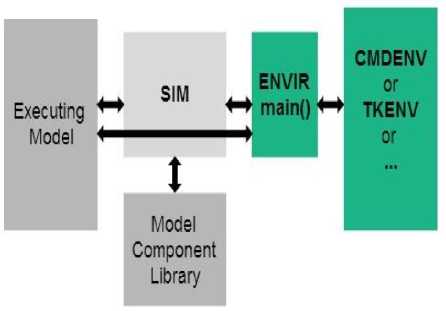
Fig. 2. Architecture of OMNeT++ Simulation Programs
OMNeT++ is an extensible, modular, open source C++ discrete event simulation environment. It is used for building simulators for wired and wireless communication networks, on-chip networks, queueing networks etc, by the designers and engineers. The architectural block diagram of OMNeT++ simulation environment is given in Fig. 2. There are 5 major components in OMNeT++ simulation program. Sim is the simulation kernel and class linked library responsible for module instantiations and building concrete simulation model. The Model Component Library contains code implementations for simple and compound modules. The user interface libraries (Envir, Cmdenv and Tkenv) provide an environment for simulation execution. The Executing Model contains objects that are instances of model component library components. This model is set up for simulation [33], [34]. OMNeT++ is appropriate for studying WSNs both with networking and distributed systems aspects. It is simpler to use due to an Eclipsebase integrated development environment (IDE) and extensive graphical user interface (GUI) support. OMNeT++ also makes it feasible to create and configure models, to perform batch executions, and analyze simulation results [24], [25], [26]. MiXiM is an OMNeT++ modeling framework, which is created for mobile and fixed wireless networks (WSNs, ad-hoc networks, body area networks, vehicular networks, etc). It offers detailed models of wireless MAC protocols, radio wave propagation, radio transceiver power consumption, and interference estimation. It extends OMNeT++ functionality by providing detailed models of the wireless connectivity, wireless channel, models for obstacles, mobility models, and many communication protocols especially at the Medium Access Control (MAC) level [27], [28].
While working with MiXiM, the file Network.ned contains the simulation network including the number of nodes and their nodes types [30]. Similarly, the Host.ned contains the compound module defining the nodes for the network [30]. It tells what will be the type of network layer, transport layer, session layer, presentation layer, application layer; mobility module, address resolution module and MAC layer as shown in Fig. 3. The file Nic.ned contains the compound module, which defines the network interface card of the hosts [30]. MAC layer type is mentioned in this file as shown in Fig. 4.
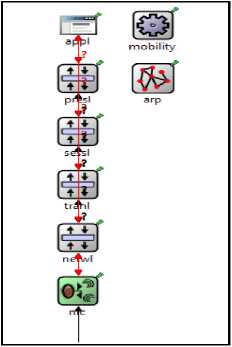
Fig. 3. Node Structure
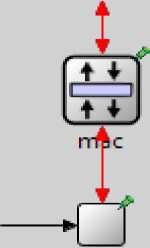
phy
Fig. 4. NIC Structure
The omnetpp.ini file allows the user to configure simulation models for execution [30]. It allows the user to specify simulation parameters, world utility parameters, parameters for the connection manager and parameters for the host. The parameters for the host include physical parameters, MAC layer parameters, application layer parameters, network layer parameters and mobility parameters. The config.xml file contains configuration for the physical layer's decider and analogue models [30]. Due to object oriented programming modular approach, it gets easier to work in MiXiM as the work is divided into different files.
MiXiM provides various MAC layer protocols including Aloha, B-MAC, L-MAC, CSMA, IEEE 802.15.4 and IEEE 802.11 [28]. Aloha is implemented in AlohaMacLayer class, which is inherited from
UWBIRMac. B-MAC and L-MAC are implemented in BMacLayer and LMacLayer classes respectively; both are inherited from BaseMacLayer [19]. IEEE 802.11 is implemented in Mac80211 class, which is inherited from BaseMacLayer. IEEE 802.15.4 is implemented in CSMA802154 class, which is inherited from csma [31]. We have two more classes namely csma and CSMAMacLayer both are inherited from BaseMacLayer and implement CSMA protocol. CSMAMacLayer implements non-persistent CSMA. csma is generic and it supports linear, constant , exponential backoffs and MAC ACKs [32]. MiXiM also provides different mobility models like constant speed, rectangular, circular mobility to model mobile scenarios. In order to adjust traffic rate MiXiM gives an attribute trafficparam. With periodic traffic, trafficparam is the constant time interval in seconds. As this time interval is decreased, performance degrades due to more loads. MiXiM can support simulations with up to 1000 nodes [23]. MiXiM uses a parameter called playground size to set the size of area.
-
B. Simulation Parameters and Experimental Setup
The experiment is performed on OMNeT++-4.3.1 version along with MiXiM-2.3 framework. In order to test MAC layer protocols a wireless sensor network is constructed with MiXiM. After this, various parameters are specified in omnetpp.ini file. These parameters, shown in Table 1, include total number of nodes, mobility, source node, destination node, traffic rate, network type, application type, playground size. Physical layer parameters including analogue models and decider type are mentioned in config.xml file. MAC type is mentioned in Nic.ned file. After initial configurations, the simulation is run and matrices including packet delivery ratio and mean latency are observed which help in performance analysis.
-
V. Observations and Results
Initially, the simulation is run with stationary nodes and later the same setup is simulated with mobile nodes. This leads to an observation that as mobility of the nodes increases the average packet delay increases [23]. In addition, traffic increase also degrades performance. The WSN is tested with 4 different MAC layer protocols namely IEEE 802.154, IEEE 802.11, B-MAC and CSMA. This paper only focuses on the impacts caused by 2 factors i.e. number of nodes and traffic param, on MAC layer protocols and on the overall mobile WSN performance.
Table 1. Simulation Parameters
|
No of hosts |
10, 25, 50 |
|||
|
Application Type |
Sensor App Layer |
|||
|
Network Type |
Flood |
|||
|
Source Node |
0 |
|||
|
Destination Node |
9, 24, 49 |
|||
|
Traffic Type |
Periodic |
|||
|
Mobility Type |
ConstSpeedMobility |
|||
|
Mobility Speed |
1 mps |
|||
|
Mobility Update Interval |
0.1 seconds |
|||
|
Source Mobility(x,y) |
(0m,0m) |
|||
|
Destination Mobility(x,y) |
(300m,300m) |
|||
|
Playground Size(x,y) |
(300m,300m) |
|||
|
Traffic Param |
0.1 Seconds, 0.005 Seconds, 0.000001Seconds |
|||
|
No of Packets sent at source |
100, 500, 1000 |
|||
|
MAC Type |
CSMA802154 (IEEE 802.154) |
csma (CSMA) |
BMacLayer (B-MAC) |
Mac80211 (IEEE 802.11) |
|
Decider Type |
Decider802154Narrow |
SNRThresholdDecider |
SNRThresholdDecider |
Decider80211 |
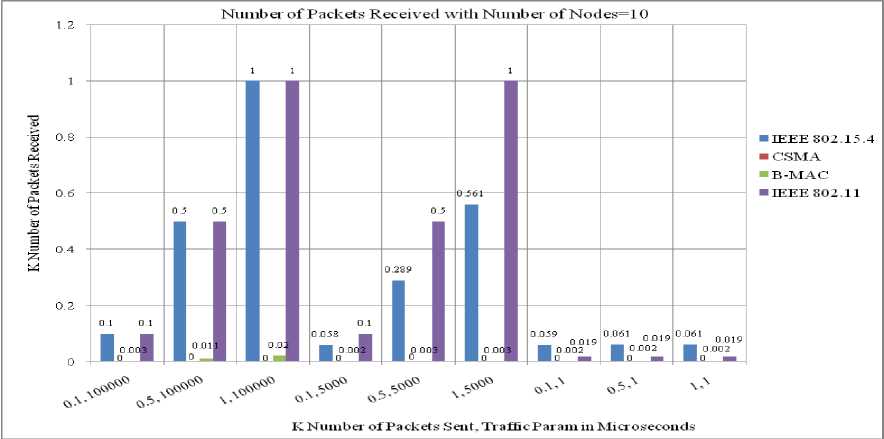
Fig. 5. K Number of Packets Received with each 4 MAC Layer Protocols at 10 Nodes

Fig. 6. Mean Latency in Milliseconds with each 4 MAC Layer Protocols at 10 Nodes
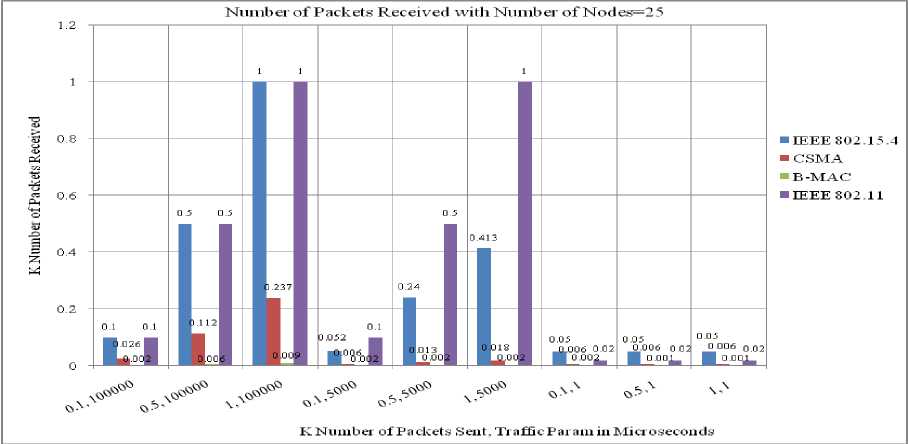
Fig. 7. K Number of Packets Received with each 4 MAC Layer Protocols at 25 Nodes
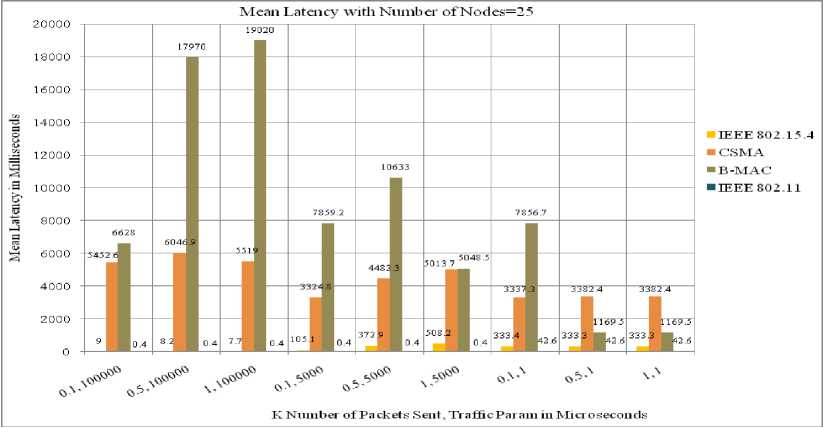
Fig. 8. Mean Latency in Milliseconds with each 4 MAC Layer Protocols at 25 Nodes
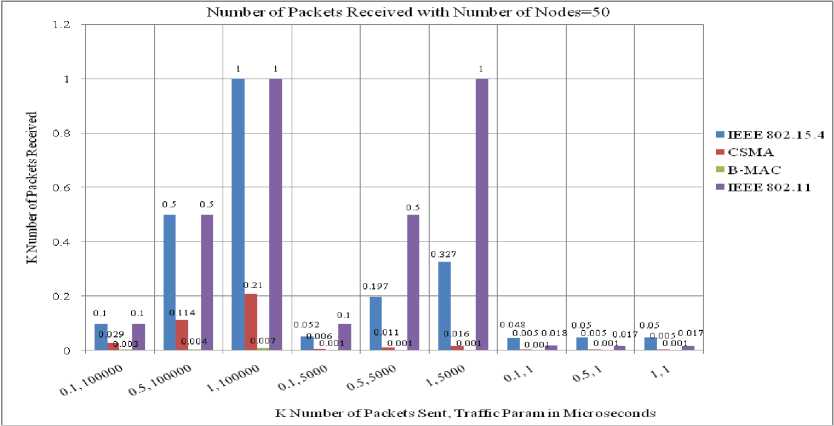
Fig. 9. K Number of Packets Received with each 4 MAC Layer Protocols at 50 Nodes
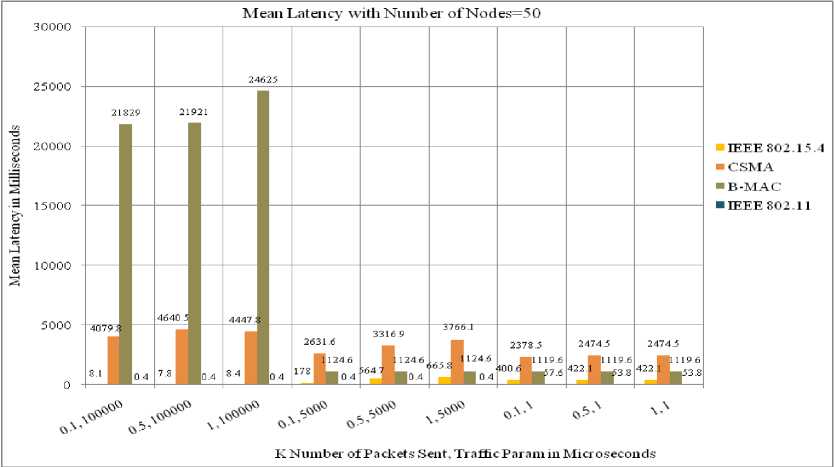
Fig. 10. Mean Latency in Milliseconds with each 4 MAC Layer Protocols at 50 Nodes
Table 2. Performance Analysis of each 4 MAC Layer Protocols with different Traffic Param and 10 Nodes
|
MAC Layer Protocols |
Traffic Param=100000µs |
Traffic Param=5000µs |
Traffic Param=1µs |
|
IEEE 802.15.4 (Mac802154) |
It performs well with average packet delivery ratio of 100%. Here the average mean latency is 7.1ms which is good but greater than IEEE 802.11. |
The performance gets dropped as traffic rate is increased. The average packet delivery ratio is 57.3% and average mean latency is 83.26ms. |
With this much traffic rate, performance is certainly dropped further. Here average packet delivery ratio is 25.7666% and average mean latency is 306.1ms. |
|
CSMA (csma) |
It performs worst. Here average packet delivery ratio and latency both are 0. |
Average packet delivery ratio is 0. |
Average packet delivery ratio is 0. |
|
B-MAC (BMacLayer) |
It performs better than CSMA but still it has very less average packet delivery ratio that is 2.4% and high average mean latency that is 9870.83ms. |
Average packet delivery ratio is 0.9666% and average mean latency is 7396.9ms better than CSMA. |
Average packet delivery ratio is 0.8666% and average mean latency is 5408.43ms better than CSMA. |
|
IEEE 802.11 (Mac80211) |
IEEE 802.11 performs well with average packet delivery ratio of 100% and average mean latency of 0.4ms which is less than IEEE 802.15.4. |
With an increase in the traffic rate the average packet delivery ratio is still 100% and latency is 0.4ms. Here it performs better than others. |
With this much traffic rate, the scheme gets collapsed before IEEE 802.15.4. The average packet delivery ratio is 8.2333% and average mean latency is |
Table 3. Performance Analysis of each 4 MAC Layer Protocols with different Traffic Param and 25 Nodes
|
MAC Layer Protocols |
Traffic Param=100000µs |
Traffic Param=5000µs |
Traffic Param=1µs |
|
IEEE 802.15.4 (Mac802154) |
It performs well with average packet delivery ratio of 100% and average mean latency of 8.3ms which is good but greater than IEEE 802.11. |
The performance gets dropped as traffic rate is increased. The average packet delivery ratio is 47.1 % and average mean latency is 328.7ms. |
With this much traffic rate, performance is dropped further. Here average delivery ratio is 21.6666% and average mean latency is 333.3ms. |
|
CSMA (csma) |
As the number of nodes is increased, CSMA performance improves. The average packet delivery ratio is 24.0333% and average mean latency is 5672.8ms. |
Average packet delivery ratio is 3.4666% and average mean latency is 4273.6ms which is too high. |
Here average packet delivery ratio is 2.6% and average mean latency is 3367.3ms. |
|
B-MAC (BMacLayer) |
Here average packet delivery ratio is 1.3666% and average mean latency is 14539.3ms and it performs worst. |
Average packet delivery ratio is 0.8666% and average mean latency is 7846.9ms. |
Here average packet delivery ratio is 0.7666% and average mean latency is 3398.5ms. |
|
IEEE 802.11 (Mac80211) |
It performs well with average packet delivery ratio of 100% and average mean latency of 0.4ms which is less than IEEE 802.15.4. |
With the increase in traffic rate the average packet delivery ratio is still 100% and latency is 0.4ms. Here it performs better than other protocols. |
With this much traffic rate, the scheme gets collapsed before IEEE 802.15.4. The packet delivery ratio is 8.6666% and average mean latency is 42.6ms. |
Table 4. Performance Analysis of each 4 MAC Layer Protocols with different Traffic Rate and 50 Nodes
|
MAC Layer Protocols |
Traffic Param=100000µs |
Traffic Param=5000µs |
Traffic Param=1µs |
|
IEEE 802.15.4 (Mac802154) |
It performs well with average packet delivery ratio of 100% and average mean latency of 8.1ms which is good but greater than IEEE 802.11. |
Performance gets dropped as traffic rate is increased. The average packet delivery ratio is 41.366% and average mean latency is 469.5ms. |
With this much traffic rate, performance gets dropped further. Here average packet delivery ratio is 21% and average mean latency is 414.9ms. |
|
CSMA (csma) |
With an increase in nodes it performs better than before with an average packet delivery ratio of 24.2666% and average mean latency of 4389.3ms. |
With an increase in traffic rate, average packet delivery ratio is 3.2666% and average mean latency is 3238.2ms. |
Here average packet delivery ratio is 2.1666% and average mean latency is 2442.5ms. |
|
B-MAC (BMacLayer) |
Here average packet delivery ratio is 1.5% and average mean latency is 22791.6ms. |
Average packet delivery ratio is 0.4333% and average mean latency is 1124.6ms. |
Here average packet delivery ratio is 0.4333% and average mean latency is 1119.6ms. |
|
IEEE 802.11 (Mac80211) |
It performs well with an average delivery ratio of 100% and average mean latency of 0.4ms which is again less than IEEE 802.15.4. |
With traffic rate increase the average packet delivery ratio is 100% and latency is 0.4ms which is the same as before. Here it again performs better than others. |
With this much traffic rate, the scheme gets collapsed before IEEE 802.15.4. The average packet delivery ratio is 7.7% and average mean latency is 55ms. |
By observing above scenario in Tables [2, 3, and 4] in the overall we can say that B-MAC protocol performs least amongst all. Then comes CSMA, which is better than B-MAC but not better than others, its packet delivery ratio is less and mean latency is high. Although, IEEE 802.11 performs best amongst all, both in terms of packet delivery ratio and latency but when the traffic rate is very high it is collapsed some time before IEEE 802.15.4. IEEE 802.15.4 shows good results but its performance matrices are still lower as compared to IEEE 802.11.
-
VI. Conclusions
MAC layer protocol plays a major role in a WSN. In order to have an efficient WSN, an appropriate MAC layer protocol must be chosen. The decision should be made considering various factors such as number of nodes, mobility of the nodes, playground size and traffic rate.
Список литературы Performance Analysis of MAC Layer Protocols in Wireless Sensor Network
- Madhav Bokare1, Anagha Ralegaonkar, "Wireless Sensor Network: A Promising Approach for Distributed Sensing Tasks", Excel Journal of Engineering Technology and Management Science, Vol. I, 2012, ISSN 2249-9032.
- Debnath Bhattacharyya, Tai-hoon Kim and Subhajit Pal, "A Comparative Study of Wireless Sensor Networks and Their Routing Protocols", MDPI Journal on Sensor, Vol. 10, 2010, pp. 10506-10523; doi: 10.3390/s101210506.
- Jianhui Zhang, Jiming Chen, Jialu Fan, Weiqiang Xu and Youxian Sun, "OMNeT++ based Simulation for Topology Control in Wireless Sensor Network: A Case Study", Proc. of IEEE International Wireless Communications and Mobile Computing Conference Proceedings, IWCMC'08 I, Crete Island, Aug. 2008, pp. 1130-1134.
- Fei Yu, "A Survey of Wireless Sensor Network Simulation Tools", http://www.cse.wustl.edu/~jain/cse567-11/ftp/sensor.pdf [January 2014].
- K.Lakshmanarao, Ch.R. VinodKumar, K.Kanakavardhini, "Survey on Simulation Tools for Wireless Networks", International Journal of Engineering Research & Technology (IJERT), Vol 2(10), 2013, pp 608-612.
- Jianliang Zheng and Myung J. Lee, "A Comprehensive Performance Study of IEEE 802.15.4",
- http://hackipedia.org/Hardware/Zigbee/A%20Comprehensive%20Study%20Of%20Ieee%20802.
- 15.4%20And%20Zigbee%20506.pdf [January 2014].
- Qicai Yu, Jianping Xing, Yan Zhou, Lei Zhou, "Performance Research and Simulation Analysis of the MAC Layer Protocols in Wireless Sensor Networks", Proc. of IEEE International Communications and Networking Conference Proceedings, ChinaCom'06, Beijing, China, October. 2006, pp. 1-3.
- Chowdhury S.A., Islam M.T., Jaigirdar F.T., Faruqui M.R.U., Al Noor S., "Performance study and simulation analysis of CSMA and IEEE 802.11 in wireless sensor networks and limitations of IEEE 802.11", Proc. of IEEE International Computers and Information Technology Conference Proceedings, ICCIT '09, Dhaka, Bangladesh, December. 2009, pp. 431-436.
- Petrova M., Riihijarvi J., Mahonen P., Labella S., "Performance study of IEEE 802.15.4 using measurements and simulations", Proc. of IEEE International Wireless Communications and Networking Conference Proceedings, WCNC 2006, Las Vegas, April. 2006, pp. 487-492.
- Lamia Chaari, Lotfi Kamoun, "Performance Analysis Of IEEE 802.15.4/Zigbee Standard Under Real Time Constraints", International Journal of Computer Networks & Communications (IJCNC), Vol.3, Sep 2011.
- Ahmad Abed Alhameed Alkhatib and Gurvinder Singh Baicher, "MAC Layer Overview for Wireless Sensor Networks", Proc. of IPCSIT International Computer Networks and Communication Systems Conference Proceedings, CNCS 2012, Vol.35, Singapore, 2012.
- Jeffrey Mehlman, "Cross-Layer Design: A Case for Standardization", http://www.jeffreymehlman.com/EE359_Research_Project_Final_JAM.pdf [January 2014].
- Kurtis Kredo II and Prasant Mohapatra, "Medium Access Control in Wireless Sensor Networks", Preprint submitted to Computer Networks 29 June 2006 http://www.spirit.cs.ucdavis.edu/pubs/journal/SensorMac.pdf [January 2014].
- Aditi .P. Khadilkar and Nitin G. Palan, "Media Access Control Protocol for Mobile Sensor Network- Modelling Using OMNeT++ -MiXiM Network Simulator", International Journal of Computer Science and Information Technologies (IJCSIT), Vol. 2 (3), 2011, pp 1154-1159.
- Se-Young Yun, Yung Yi, Jinwoo Shin and Do Young Eun, "Optimal CSMA: A Survey ", Proc. of IEEE international Communication Systems Conference Proceedings, ICCS, Singapore, Nov. 2012, pp. 199-204.
- A.O Afolabi, S.O Olabiyisi, "Application of Routing Algorithm to Congestion Control in GSM Network", Proc. of Engineering World Congress Proceedings, Vol II, London, U.K, July. 2012.
- Rajesh Yadav, Shirshu Varma, N. Malaviya, "A Survey of MAC Protocols for Wireless Sensor Networks", UbiCC Journal, Volume 4, No. 3, Aug. 2009.
- Qiang Ni*, Lamia Romdhani, Thierry Turletti, "A Survey of QoS Enhancements for IEEE 802.11 Wireless LAN", Journal of Wireless Communications and Mobile Computing, Vol 4(5), 2004, pp.547-566.
- Anna F?rster, "Implementation of the B-MAC Protocol for WSN in MiXiM", http://www.omnet-workshop.org/2011/uploads/slides/OMNeT_WS2011_S5_C1_Foerster.pdf [January 2014].
- Himanshu Singh, Bhaskar Biswas, "Comparison of CSMA based MAC Protocols of Wireless Sensor Networks",http://arxiv.org/ftp/arxiv/papers/1205/1205.1701.pdf [January 2014].
- Uro? Pe?ovic′, Aleksandar Peulic′, ?arko Cˇ ucˇej, "MAC protocols for wireless sensor networks", Elektrotehni?ki vestnik 75(1): Electrotechnical Review, Ljubljana, Slovenija, 2008, pp 50-55.
- E. Egea-Lo′pez, J. Vales-Alonso, A. S. Mart?′nez-Sala, J. Garc?′a-Haro, P. Pavo′ n-Marin?o , M. V. Bueno Delgado, "A wireless sensor networks MAC protocol for real-time applications", Pers Ubiquit Comput, DOI 10.1007/s00779-006-0111-6.
- Palan, Nitin G.; Khadilkar, Aditi.P ., "Media Access Control Protocol Modelling for Mobile Sensor Network- Using OMNeT++ -MiXiM Network Simulator", Proc. of IEEE International Sustainable Energy and Intelligent Systems Conference Proceedings, SEISCON 2011, Chennai, India, July. 2011, pp.641-644.
- OMNeT++, "OMNeT++ Documentation", http://www.omnetpp.org/ [January 2014].
- C. Mallanda, A. Suri, V. Kunchakarra, S.S. Iyengar, R. Kannan* and A. Durresi, "Simulating Wireless Sensor Networks with OMNeT++", http://www.csc.lsu.edu/sensor_web/sensor_simulator/SensorSimulator-ACM-Computers.pdf [January 2014].
- OMNeT++ Documentation, "OMNeT++ User Guide", http://www.omnetpp.org/doc/omnetpp/UserGuide.pdf.
- MiXiM Documentation, http://mixim.sourceforge.net/ [January 2014].
- A. Kopke, M.Swigulski, K. Wessel, D. Willkomm, P. T. K. Haneveld, T. E. V. Parker, O. W. Visser, H. S. Lichte, and S. Valentin, "Simulating wireless and mobile networks in OMNeT++ the MiXiM vision", Proc. of 1st International OMNeT++ Workshop, Mar. 2008.
- NED Overview, "OMNeT++ User Manual", http://www.omnetpp.org/doc/omnetpp/manual/usman.html#sec116 [January 2014].
- MiXiM, "MiXiM Network", http://sourceforge.net/apps/trac/mixim/wiki/HowToStart [January 2014].
- Pedro Jorge Teixeira Sousa, "Evaluation of Analytic Interference, Reception and Detection Modeling for IEEE 802.15.4 Networks with the MiXiM Omnet++ Framework", Master's Degree Project Stockholm, Sweden.
- MiXiM Classes, http://mixim.sourceforge.net/doc/MiXiM/doc/doxy/a00067.html#details [January 2014].
- OMNeT++ Simulation Architecture, "OMNeT++ User Manual", http://omnetpp.org/doc/omnetpp/Manual.pdf [January 2014].
- András Varga, Rudolf Hornig, "An overview of the OMNeT++ simulation environment", http://omnetpp.org/doc/workshop2008/omnetpp40-paper.pdf [January 2014].
- Malika BELKADI, Rachida AOUDJIT, Mehammed DAOUI, Mustapha LALAM, "Energy-efficient Secure Directed Diffusion Protocol for Wireless Sensor Networks", International Journal of Information Technology and Computer Science(IJITCS), 2013, pp-50-56.
- Sanjeev Puri and S. P. Tripathi, "Dynamic High Level Cross Layer Security Mechanisms for Wireless Sensor Networks" International Journal of Information Technology and Computer Science (IJITCS), 2012, pp-45-56.

